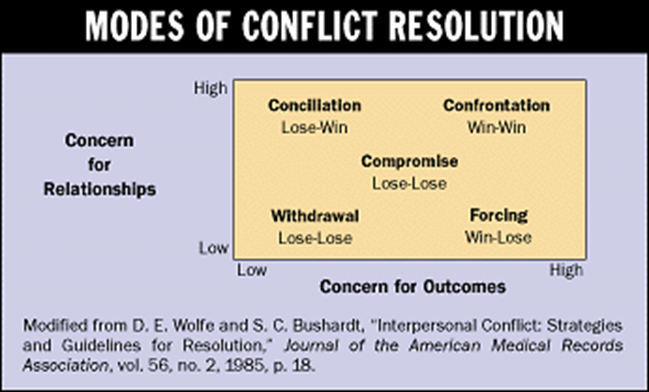To resolve a conflict between staff members regarding potential changes in policy, a nurse manager decides to implement the changes she prefers regardless of the feelings of those who oppose those changes. Which of the following conflict resolution strategies is the nurse manager using?
Cooperating
Collaborating
Competing
Compromising
The Correct Answer is C
A. Cooperating involves finding a middle ground and working together, which isn't reflected in the manager's unilateral decision-making.
B. Collaborating involves working together toward a solution that accommodates various perspectives, which isn't the case here.
C. Competing involves asserting one's own concerns at the expense of others' viewpoints, which aligns with the manager's decision to implement changes regardless of opposition.
D. Compromising entails finding a middle ground that satisfies all parties involved, which isn't evident in the manager's decision-making process.

Nursing Test Bank
Naxlex Comprehensive Predictor Exams
Related Questions
Correct Answer is C
Explanation
A. Instructing the AP to request assistance when unsure about a task is important for future situations, but it does not immediately address the current incorrect transfer, which could pose a risk to the client.
B. Demonstrating the proper client transfer technique for the AP directly addresses the immediate issue, ensuring the client is safely transferred and the AP learns the correct method through observation and practice.
C. Helping the AP assist the client with the transfer ensures the client's safety in the moment, but it does not provide the AP with the knowledge or skills needed to perform the task correctly in the future.
D. Referring the AP to the facility procedure manual is useful for long-term learning, but it does not provide the immediate guidance needed to correct the current unsafe transfer.
Correct Answer is B
Explanation
A: Right-sided flank pain and diaphoresis could indicate a kidney stone or infection, which is painful but not immediately life-threatening.
B: Shortness of breath combined with pain in the neck and shoulder could suggest a myocardial infarction (heart attack), which is a medical emergency requiring immediate attention.
C: Active bleeding from a puncture wound is concerning and requires prompt intervention, but it may not be as immediately life-threatening as a potential heart attack.
D: A raised red skin rash could be a sign of an allergic reaction or infection. While it may require medical attention, it is not as urgent as a potential myocardial infarction.
Whether you are a student looking to ace your exams or a practicing nurse seeking to enhance your expertise , our nursing education contents will empower you with the confidence and competence to make a difference in the lives of patients and become a respected leader in the healthcare field.
Visit Naxlex, invest in your future and unlock endless possibilities with our unparalleled nursing education contents today
Report Wrong Answer on the Current Question
Do you disagree with the answer? If yes, what is your expected answer? Explain.
Kindly be descriptive with the issue you are facing.
